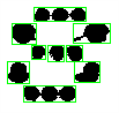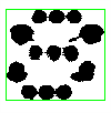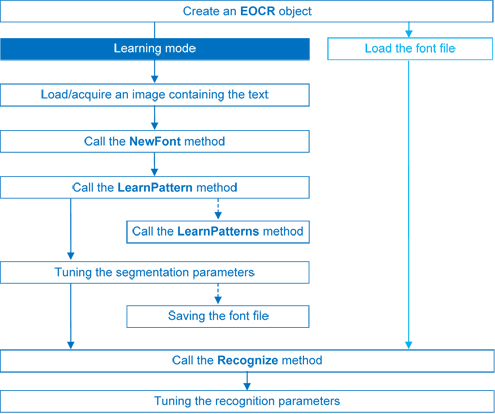EasyOCR optical character recognition library reads short texts (such as serial numbers, part numbers and dates).
It uses font files (pre-defined OCR-A, OCR-B and Semi standard fonts, or other learned fonts ) with a template matching algorithm that can recognize even badly printed, broken or connected characters of any size.
There are 4 steps to recognizing characters:

|

|

|

|
| 1. Raw image | 2. Object segmentation | 3. Character isolation | 4. Character recognition |
You can learn characters to create font file if required.
Characters are presented one by one to EasyOCR which analyzes them and builds a database of characters called a font. Each character has a numeric code (usually its ASCII code) and belongs to a character class (which may be used in the recognition process).
Font files are created as follows:
- NewFont clears the current font.
- LearnPattern or LearnPatterns adds the patterns from the source image to the font.
Patterns are ordered by their index value, as assigned by the FindAllChars process.
The patterns in a font are stored as a small array of pixels, by default 5 pixels wide and 9 pixels high. This size can be changed before learning, using parameters PatternWidthand PatternHeight. - RemovePattern removes unwanted patterns (optional).
- Save writes the contents of the font to a disk file with parameter values: NoiseArea, MaxCharWidth, MaxCharHeight, MinCharWidth, MinCharHeight, CharSpacing, TextColor.
- EasyOCR analyses the blobs to locate the characters and their bounding box, using one of two segmentation modes:
- keep objects mode: one blob corresponds to one character.
- repaste objects mode: the blobs are grouped into characters of a nominal size. This is useful when characters are broken or made up of several parts. When a blob is too large to be considered a single character, it can be split automatically using CutLargeChars.


Character segmentation by blob grouping
2. Filters remove very large and very small unwanted features.
3. EasyOCR processes the character image to normalize the size into a bounding box, extracts relevant features, and stores them in the font file. The patterns in a font are stored as arrays of pixels defined by PatternWidth and PatternHeight (by default 5 pixels wide and 9 pixels high).
Segmentation parameters must be the same during learning and recognition. Good segmentation improves recognition.
- The Threshold parameter helps separate the text from the background.
A too high value thickens black characters on white background and may cause merging, a too small value makes parts disappear.
If the lighting conditions are very variable, automatic thresholding is a good choice.



Too high threshold value (left), Threshold adjustment (middle), Too low threshold value (right)
- NoiseArea: Blob areas smaller than this value are discarded. Make sure small character features are preserved (i.e., the dot over an "i" letter).
- MaxCharWidth, MaxCharHeight: Maximum character size. If a blob does not fit in a rectangle with these dimensions, it is discarded or split into several parts using vertical cutting lines. If several blobs fit in a rectangle with these dimensions, they are grouped together.
- MinCharWidth, MinCharHeight: Minimum character size. If a blob or a group of blobs fits in a rectangle with these dimensions, it is discarded.
- CharSpacing: The width of the smallest gap between adjacent letters. If it is larger than MaxCharWidth it has no effect.
If the gap between two characters is wider than this, they are treated as different characters. This stops thin characters being incorrectly grouped together. - RemoveBorder: Blobs near image/ROI edges cannot normally be exploited for character recognition. By default, they are discarded.
The characters are compared to a set of patterns, called a font. A character is recognized by finding the best match between a character and a pattern in the font. After the character has been located, it is normalized in size (stretched to fit in a predefined rectangle) for matching. The normalized character is compared to each normalized template in the font database and the best matches are returned.
- Load: reads a pre-recorded font from a disk file.
- BuildObjects: The image is segmented into objects or blobs (connected components) which help find the characters. This step can be bypassed if the exact position of the characters is known. If the character isolation process is bypassed, you must specify the known locations of the characters: AddChar and EmptyChars.
- FindAllChars: selects the objects considered as characters and sorts them from top to bottom then left to right.
- ReadText: performs the matching and filters characters if the marking structure is fixed or a character set filter was provided.
Character recognition: The characters are compared to a set of patterns, called a font.
The best match is stretched to fit in a predefined rectangle and compared to each normalized template in the font database.
A Character set filter can improve recognition reliability and run time by restricting the range of characters to be compared. For instance, if a marking always consists of two uppercase letters followed by five digits, the last of which is always even, it is possible to assign each character a class (maximum 32 classes) then set the character filter to allow the following classes at recognition time: two uppercase, four even or odd digits, one even digit.
Steps 2 to 4 can be repeated at will to process other images or ROIs. The Recognize method can be used as well.
Additional information, such as geometric position of the detected characters, can be obtained using: CharGetOrgX, CharGetOrgY, CharGetWidth, CharGetHeight, ...
CompareAspectRatio makes character and font comparison sensitive to the difference between narrow and wide characters. It improves recognition when characters look like each other after size normalization.
- MaxCharWidth, MaxCharHeight: if a blob does not fit within a rectangle with these dimensions, it is not considered as a possible character (too large) and is discarded. Furthermore, if several blobs fit in a rectangle with these dimensions, they are grouped together, forming a single character. The outer rectangle size should be chosen such that it can contain the largest character from the font, enlarged by a small safety margin.
- MinCharWidth, MinCharHeight: if a blob or a group of blobs does fit in a rectangle with these dimensions, it is not considered as a possible character (too small) and is discarded. The inner rectangle size should be chosen such that it is contained in the smallest character from the font, shrunk by a small safety margin.
- RemoveNarrowOrFlat: Small characters are discarded if they are narrow or flat. By default they are discarded when they are both narrow and flat.
- CharSpacing: if two blobs are separated by a vertical gap wider than this value, they are considered to belong to different characters. This feature is useful to avoid the grouping of thin characters that would fit in the outer rectangle. Its value should be set to the width of the smallest gap between adjacent letters. If it is set to a large value (larger than MaxCharWidth), it has no effect.
- CutLargeChars: when a blob or grouping of blobs is larger than MaxCharWidth, it is discarded. When enabled, the blob is split into as many parts as necessary to fit and the amount of white space to be inserted between the split blobs is set by RelativeSpacing. This is an attempt to separate touching characters.
- RelativeSpacing: when the CutLargeChars mode is enabled, setting this value allows specifying the amount of white space that should be inserted between the split parts of the blobs.

Invalid recognition settings
These recognition parameters can be tuned to optimize recognition:
- Keep objects mode: a character is a blob; no attempt is made to group blobs, thus damaged characters cannot be handled and small features such as accents and dots may be discarded by the minimum character size criterion.
- Repaste objects mode: blobs are grouped to form distinct characters if they fit in the maximum character size and are not separated by a vertical gap, thus preserving accents and dots.

